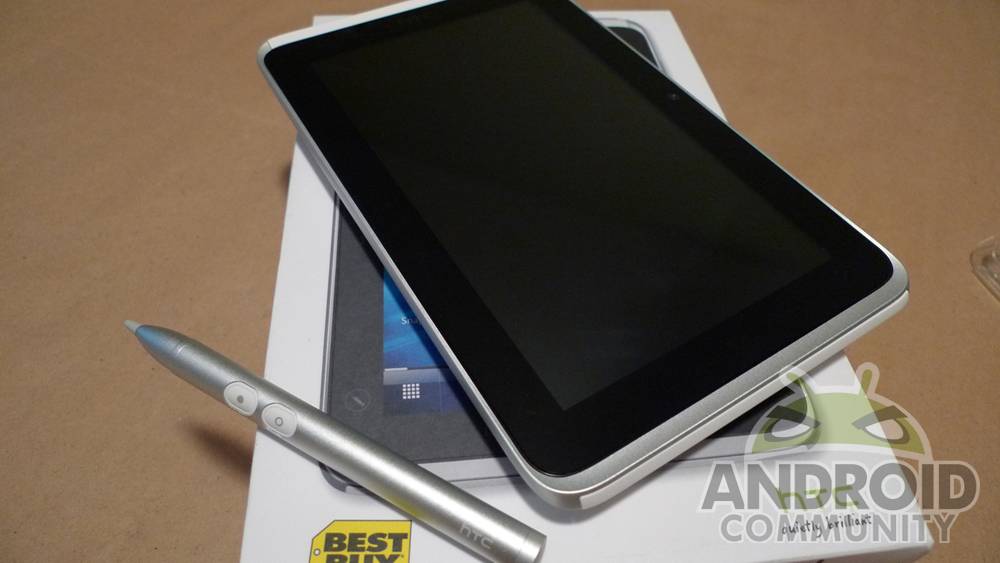
Several weeks ago we were holding the HTC Flyer for the first time, a brand new tablet running a unique version of HTC’s Sense user interface on top of Android 2.3 Gingerbread, all in a mid-sized tablet form factor with a special “Scribe” stylus for on-screen writing. We got to look at this device as the HTC Flyer (a Wi-fi version of the tablet) and the HTC EVO View, a WiMAX-capable black instead of white plastic casing version. Now what we’ve got coming down the underground pipeline is a Honeycomb upgrade for the full tablet experience!
But wait, wasn’t HTC able to get ahold of Honeycomb back when they first started producing the HTC Flyer? We’d like to think that they were able to do so since the Motorola XOOM had already technically been released right around that time earlier this year, and certainly several Android 3.x Honeycomb devices had been released before the Flyer was sent out to stores, so what gives? More than likely it was simply much more feasible to build Sense around Gingerbread at the time of development for this device than it was to work with Honeycomb.
Now we’ve got this totally-unauthorized BETA, and an early Beta at that, build of Honeycomb for the HTC Flyer in RUU – you can access it at MoDaCo courtesy of Paul – if you should take the risk and run it, let us know how it goes. Meanwhile check out what we know about the AT&T HTC Jetstream, the manufacturer’s first 10-inch tablet and first device running Honeycomb. We’ll more than likely take a look at the tablet before it’s released to the public having been excited about its existence since it was simply called the Puccini.
[device id=199]










The Flyer didn’t support Honeycomb at launch because Google didn’t add support for 1024×600 screen resolution until Android 3.2, which came out relatively recently. I know because I recently spent a week refactoring all the layout code in my Honeycomb tablet app to make it properly support that screen size after the 3.2 SDK was released.
On a related note, refactoring my app to fully support the Flyer’s resolution was a non-trivial process. Google has historically always made it easy to support multiple screen resolutions on Android phones by making the system automatically scale things for you as long as you follow their patterns, but they’ve adopted a new approach with 7″ tablets on Honeycomb that involves an almost entirely manual process that requires the developer to define every location and size value twice. This change won’t affect future hi-res 10″ tablets, which will be covered by the same automatic scaling that phones use, but almost all 7″ tablets are going to require every developer to write in specific support for them to ensure that everything displays correctly.
I mention this because buyers of this or any other 7″ Honeycomb tablet should be prepared for the possibility that they won’t be able to run the full selection of Honeycomb apps that their 10″ brethren enjoy. It’s impossible to know how wide-spread the problems will be until people start buying those tablets and testing out the apps, but it’s pretty likely that the ride won’t be entirely smooth right away.
The Flyer didn’t support Honeycomb at launch because Google didn’t add support for 1024×600 screen resolution until Android 3.2, which came out relatively recently. I know because I recently spent a week refactoring all the layout code in my Honeycomb tablet app to make it properly support that screen size after the 3.2 SDK was released.
On a related note, refactoring my app to fully support the Flyer’s resolution was a non-trivial process. Google has historically always made it easy to support multiple screen resolutions on Android phones by making the system automatically scale things for you as long as you follow their patterns, but they’ve adopted a new approach with 7″ tablets on Honeycomb that involves an almost entirely manual process that requires the developer to define every location and size value twice. This change won’t affect future hi-res 10″ tablets, which will be covered by the same automatic scaling that phones use, but almost all 7″ tablets are going to require every developer to write in specific support for them to ensure that everything displays correctly.
I mention this because buyers of this or any other 7″ Honeycomb tablet should be prepared for the possibility that they won’t be able to run the full selection of Honeycomb apps that their 10″ brethren enjoy. It’s impossible to know how wide-spread the problems will be until people start buying those tablets and testing out the apps, but it’s pretty likely that the ride won’t be entirely smooth right away.